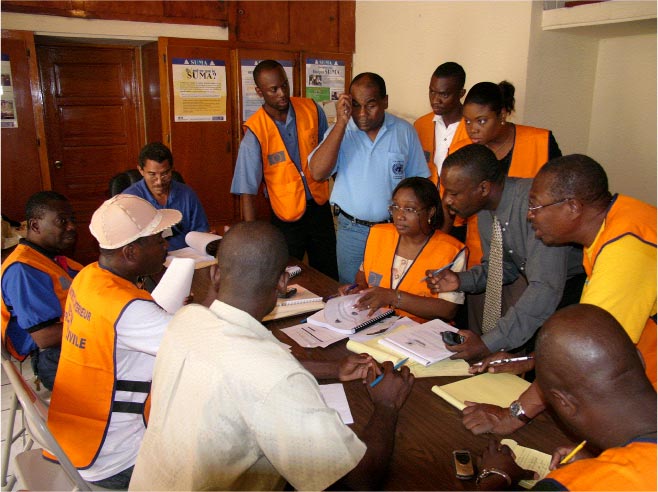Haiti’s Civil Protection Office
Risk context in Haiti
Although there has been no strong seismic activity in the past several centuries, Haiti does have a high level of seismic risk. The country is also highly exposed to hurricanes, in addition to risks associated with political, socio-economic, institutional, and above all environmental vulnerability conditions, as well as the annual recurrence of floods. These phenomena have had a high impact in the regions of Fonds-verrettes, Mapou, and Gonaives, and low to medium impact in other areas.

Photo: Civil Protection Haiti
Background on the State commitment and legal framework
The Pre-Disaster and Relief Organization (Organisation Pré-Désastre et de Secours — OPDES) was created in 1988 to work on issues related to warnings, evacuation, and humanitarian assistance. By decree of the Ministry of Interior, the Civil Protection Office was established in 1999, with a broader mission and a primary focus on risk management.
The first act of this institution was the development and validation of the National Plan for Disaster and Risk Management, which defines the State policy on the issue. The Plan also specifies its structure and three strategic areas: disaster management at the central level, risk management, also at the central level, and disaster and risk management at the local level.
A national risk and disaster management system
All stakeholders are involved in this system: the public sector, local communities, the international community, the Red Cross, and civil society organizations.
Risk and disaster management programs at the central and local levels: Some activities carried out to date
• Institutional strengthening
• Creation and strengthening of the committees of the Emergency Operations Centres (COE)
• Early warning systems
• Mitigation activities
• Awareness-raising activities with both the population and decision-makers
• Inclusion of risk management in public and private policy
• Disaster response
• Integration of regional and international networks
Since 2000, the State has focused on the plan implementation. We receive assistance from the international community through various projects and programs sponsored by UNDP, the European Union, the World Bank, and the Inter-American Development Bank. Fortunately, a synergy has been established and there is a platform in place so that these programs are coordinated in an adequate manner. Nevertheless, efforts still focus on disaster response; that is, more attention is paid to managing the effects of disasters rather than the causes. Now, as the Poverty Reduction Strategic Paper (PRSP) is being prepared, we are taking advantage of this moment to raise awareness among the population, and incorporate risk management into public policy. The central government has taken the first step by investing funds this year to address risk-related issues.
For further information, please contact:
Marie Katleen Mompoint, katmompoint@yahoo.fr
Ministry of the Interior – Civil Protection Office
|

